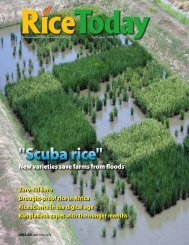A sunburned grain Stamps of approval Pockets of gold in ... - adron.sr
A sunburned grain Stamps of approval Pockets of gold in ... - adron.sr
A sunburned grain Stamps of approval Pockets of gold in ... - adron.sr
You also want an ePaper? Increase the reach of your titles
YUMPU automatically turns print PDFs into web optimized ePapers that Google loves.
a<strong>in</strong>RICEGROWERS' ASSOCIATION OF AUSTRALIAReport<strong>in</strong>g the impact <strong>of</strong> an 8-yeardrought on rice production is astrange caper, I thought, as thewheels <strong>of</strong> a four-wheel motorbikecovered me head to toe with mud. Iwas sitt<strong>in</strong>g beh<strong>in</strong>d Rob Houghton, afarmer from just outside Leeton <strong>in</strong> theAustralian state <strong>of</strong> New South Wales,who was driv<strong>in</strong>g me through the pour<strong>in</strong><strong>gra<strong>in</strong></strong> to his ... soybean field. When I metMr. Houghton, I expected him to takeme to his rice field. The problem is, he’snot grow<strong>in</strong>g any this year. Despite themorn<strong>in</strong>g’s deluge, Mr. Houghton wasn’tallocated enough water this season toensure a good rice crop. The alternativewas soybeans, which, although not aspr<strong>of</strong>itable (see Table), don’t need as muchwater.“There have been only 2 yearss<strong>in</strong>ce my father started grow<strong>in</strong>g ricehere <strong>in</strong> 1942 that we haven’t grown rice,and they’ve been <strong>in</strong> the last 5 years—this year and 2 years ago,” says Mr.Houghton.Australian rice production from1999 to 2002 averaged more than 1.3million tons per year. In 7 years, from2003 to 2009, the average was less than360,000 tons. The 2008 harvest saw thelowest production s<strong>in</strong>ce the <strong>in</strong>dustrybegan <strong>in</strong> Australia, at a mere 19,000 tons(see figure below). The drought averageis actually flattered by a million-ton cropWater use, productivity, and pr<strong>of</strong>itability for 2006summer crops <strong>in</strong> the Murrumbidgee Irrigation AreaCrop Megaliters AU$/ha AU$/MLRice 13.5 1,675 124Cotton 10 1,136 114Lucerne 10 2,197 220Maize 8.5 839 99Soybean 8 483 60Data source: Compiled by Laurie Lew<strong>in</strong> from summer cropgross marg<strong>in</strong>s at www.dpi.nsw.gov.au (now www.<strong>in</strong>dustry.nsw.gov.au)1,3811,0881,7441,2413905291999 2000 2001 2002 2003 2004 2005 2006 2007 2008 2009Crop yearAustralian rice production (1999-2009).Data source: SunRice305<strong>in</strong> 2006, partly the result <strong>of</strong> an advance<strong>of</strong> growers’ future years’ water. The2010 crop is expected to br<strong>in</strong>g <strong>in</strong> around185,000 tons.Mr. Houghton farms 520 hectares<strong>in</strong> the River<strong>in</strong>a region <strong>of</strong> southwest NewSouth Wales, which <strong>in</strong>cludes the MurrayValley, Murrumbidgee, and ColeamballyIrrigation Areas (see map on page 16).Overall, the region is home to around1,500 rice-farm<strong>in</strong>g families.Before the drought began <strong>in</strong>2002, Mr. Houghton grew a rice crop<strong>of</strong> 100–150 hectares each Australiansummer (plant<strong>in</strong>g <strong>in</strong> October-Novemberand harvest<strong>in</strong>g <strong>in</strong> March-April). His farmyielded about 10 tons per hectare. S<strong>in</strong>cethe ra<strong>in</strong>s failed, that area for rice hasfallen to an average <strong>of</strong> around 30 hectaresper year, exclud<strong>in</strong>g the seasons <strong>in</strong> whichhe grew no rice at all.“The summer crop is where wereally make our money,” says Mr.Houghton. “In drought times, though,we’ve really ramped up our w<strong>in</strong>ter cropprogram because your water goes somuch further.”The long-term lack <strong>of</strong> ra<strong>in</strong> hasnot only reduced the amount <strong>of</strong> wateravailable to farmers, but it has also<strong>in</strong>creased water requirements when riceis grown. In better times, Mr. Houghtonneeded 13 million liters (megaliters) <strong>of</strong>water per hectare per season to grow rice.In the 2008-09 season, with water tabless<strong>in</strong>k<strong>in</strong>g lower and lower after almosta decade <strong>of</strong> drought, the figure was 22megaliters.“We just need a good wet w<strong>in</strong>terto sort that out,” says Mr. Houghton.“It’s only a short-term impact, butyou can’t grow rice economicallyus<strong>in</strong>g 22 megaliters per hectare and,environmentally, it’s not a sound moveeither.”Paddy delivered (thousand tons)1,04016619 66Water shar<strong>in</strong>gAside from limit<strong>in</strong>gcrop choices, hesays that the dryspell has forcedthe region’s ricegrowers to makefundamentalchanges to the waythey farm. Growersare becom<strong>in</strong>g muchcannier <strong>in</strong> the wayRice Today April-June 201013

















